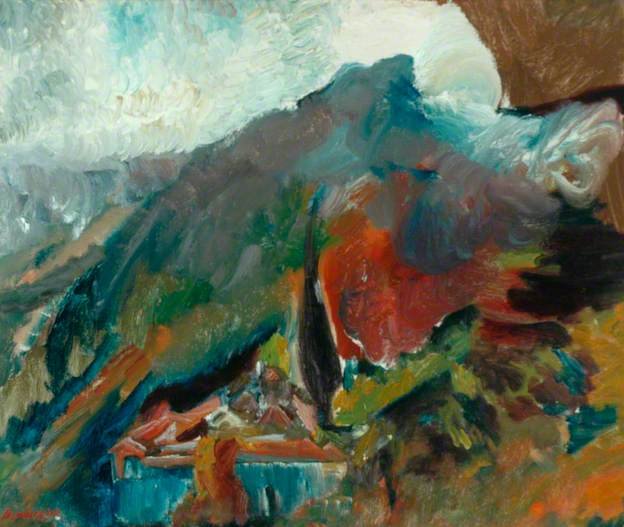Asylum seekers
 Between 1933 and 1945, more than 300 Jewish artists took refuge in Britain: painters, sculptors, graphic artists and designers, several with established careers in Germany and Austria. Many were forced to flee after blacklisting by the Reichskulturkammer set up by Joseph Goebbels in 1933. For others, inclusion in the Nazi’s notorious “Degenerate Art Exhibition” of 1937 sealed a professional death warrant.
Between 1933 and 1945, more than 300 Jewish artists took refuge in Britain: painters, sculptors, graphic artists and designers, several with established careers in Germany and Austria. Many were forced to flee after blacklisting by the Reichskulturkammer set up by Joseph Goebbels in 1933. For others, inclusion in the Nazi’s notorious “Degenerate Art Exhibition” of 1937 sealed a professional death warrant.
Escape to Britain, however, was no holiday. During the Second World War, the refugees were interned as “enemy aliens”. But for some, internment camp became a home from home. At Hutchinson on the Isle of Man, the main camp for artists, the Expressionist painter Ludwig Meidner found the cultured atmosphere so congenial to work that he applied for an extension to his stay.
On release from internment, these post-war migrants joined the earlier waves of Jewish refugees from the Russian pogroms of the turn of the century. But assimilation was never more than partial. After the artist Solomon Hart was elected the first Jewish R.A. in 1840, his fellow Academician Sir William Collins still felt it necessary, on taking him home, to explain to his children: “Mr Hart is a Jew, and the Jews crucified our saviour, but he is a very good man for all that.”
Hart’s portrait of a young Queen Victoria (1842) presides at the entrance to “Out of Chaos; Ben Uri: 100 Years in London” (until 13 December), a special exhibition at Somerset House celebrating the centenary of the Ben Uri Gallery (temporarily based in St John’s Wood). The show’s modest-sized rooms magnify the extraordinary impact that Jewish immigration had on modern British art.
Its first big jolt to the establishment system was delivered in the early 1910s by a group of young East Enders, including David Bomberg and Mark Gertler, sponsored by the Jewish Education Aid Society to study at the Slade. These so-called “Whitechapel Boys” brought a native chutzpah to their interpretation of the school’s traditional teachings. The Birmingham-born Bomberg remembered a friend “wanted to dynamite the whole of English painting”. When his Futurist watercolour of Racehorses was shown at the Whitechapel Gallery in 1914, The Jewish Chronicle objected that his “horses could never possibly win races”. But the ones in his drawing of 1913 in this exhibition seem tame by comparison with the mechanical horses in Gertler’s terrifying Merry-Go-Round (1916), a wartime painting that transforms a funfair carousel into a garish whirligig of insensate horror.
The Ben Uri owned Merry-Go-Round until 1984, when it had to sell it to the Tate to secure its future. Founded in 1915 to support Jewish artists and build a museum collection of their work, the Ben Uri Gallery was a lifeline for immigrant artists ignored by the British art establishment. The new generation of Jewish artists was not easily assimilated into the English art world. The style of German Expressionism they practised was a foreign language to an English modern art establishment in thrall to Paris. When the Ben Uri held a joint exhibition of Ludwig and his wife, Else Meidner, in 1949, it met with such a resounding silence that Ludwig within three years had returned to Germany, where his reputation recovered.
It was Jewish dealerships such as Marlborough Fine Art, founded in 1946 by Viennese émigrés Frank Lloyd and Harry Fischer that made the careers of the next generation of Anglo-Jewish artists. On the end wall of this exhibition, the Expressionist brushwork and vibrant colours of Frank Auerbach’s Mornington Crescent, Summer Morning II (2004) remind us of the irony that, with the exception of the Irish-born Francis Bacon, the leaders of the so-called School of London – Britain’s post-war riposte to the School of Paris – were Jews. Both Auerbach and Lucian Freud came to Britain as children in the 1930s.
“These refugees from Nazism,” writes Brian Sewell in the catalogue, “broadened the scope of our galleries and dented the belief, established by Roger Fry, that no art of any quality had ever come from beyond the Rhine.” More than that – as vigorous drawings by Meidner, Auerbach and Leon Kossoff demonstrate – the immigrant artists had lead in their pencils. Through teaching in art schools, they injected their vigour into the next generation.
Auerbach and Kossoff were both taught by Bomberg at his legendary evening classes at Borough Polytechnic, and Gillian Ayres R.A. recalls how at Camberwell the German Expressionist Martin Bloch “swept the life-room” of stuffy convention.
Bomberg did not dynamite British painting, but he did put a bomb under it. You have only to compare his Evening in the City of London (1944) in the Museum of London – with its fiery vision of St Paul’s Cathedral rising from the ruins of the Blitz – with John Piper’s 1940 elegy to a gutted Coventry Cathedral in Manchester Art Gallery, to appreciate the difference. While English neo-Romantics dwelt on the past, Jewish immigrants looked to the future: a future rooted in the urban multicultural Britain of their own experience, captured in Auerbach’s glowing Camden cityscapes and in his contemporary Eva Frankfurther’s marvellous painting of the West Indian Waitresses (1955), whom she worked alongside at Lyons Corner House.
“Our century is the century of the big city!” was Meidner’s war cry. “We need to paint the truth! The city’s savagery, its chaos and the dark passions pent up in man!” It was a wake-up call to an enervated English art world that, without it, might have gone on dreaming of the past.


 Votes : 0
Votes : 0









